My Top 5 Games of 2014 (that didn't actually come out in 2014)
By Wemibelle 6 Comments
I played a lot of games in 2014. My intent was to make a dent in my massive backlog, tackling game after game in hopes of bringing the list down to a more manageable size. As a result, I finished over 80 games (most of them in the first half of the year, even) and dabbled in nearly twice that. While I wrote reviews for some of these completed games, I didn’t have the time to say my piece on all of them, even though a few were some of my favorite gaming experiences of the year. So, I thought I’d do so here. I’m going to highlight my 5 favorite games I played in 2014 that didn’t originally release in 2014 (and were therefore exempt from my Top 10 list) and let you know why you should give them a shot. Maybe you’ll enjoy them as much as I did.
Ghost Trick: Phantom Detective (finished on April 7)
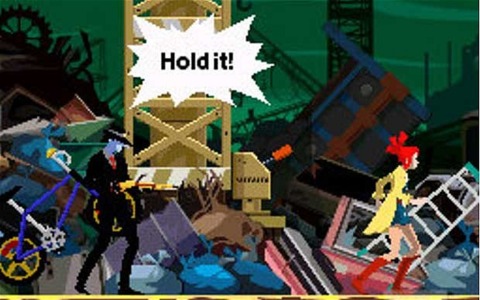
I missed the original fervor that followed in the wake of Ghost Trick’s release. It seemed like a neat game, based off the Quick Look for it, but it wasn’t something that grabbed my interest enough for a purchase. It sat on my to-play list for years before I received it as a gift at Christmas 2013. I didn’t get around to playing it until next April, but it was well worth the 8-10 hours it took me to finish. Ghost Trick is a puzzle game that revolves around shifting between objects in the environment and “tricking” to manipulate them in a variety of ways. You maneuver between and affect these items in hopes of preventing the untimely death of one of the game’s characters in each level. This usually means puzzling out, and enacting, a Rube Goldberg-esque sequence of events that finally pushes that person out of the way of harm or drops something on an impending murderer. These puzzles are a great deal of fun to figure out, tasking you to test each of the objects in the environment and how they interact with one another before finding the optimal path to a key item.
Later on, Ghost Trick introduces another entity that you can switch to with different types of powers, making the puzzles that much trickier. The brainteasers managed to never get old and always stumped me just long enough that I felt smart and not frustrated; it’s a master class in puzzle design. All of this gameplay is paired with a dense, twisting story that goes to some crazy places you likely won’t anticipate. The game is quite a looker as well, with gorgeous high-detail art and rotoscoped animation that is so smooth it has to be seen to be believed. Ghost Trick is a fantastic package, mixing sharp puzzles and amazing graphics to create something unexpected. Thankfully, it’s been available on iOS for some time, making it easy to experience now!
I Have No Mouth and I Must Scream (finished on May 5)
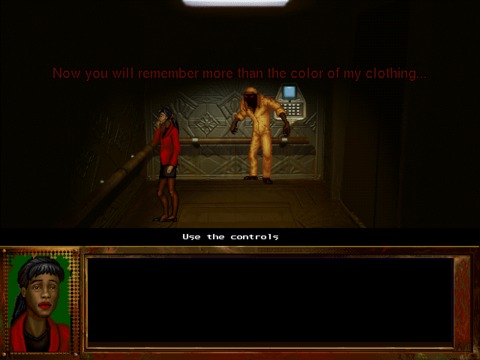
I Have No Mouth and I Must Scream was one of those games that I almost felt ashamed to have missed out on for so long. Once it was out on GoG, and once I owned it, I really had no excuse to hesitate any longer. Last May, I decided enough was enough. I installed the game, grabbed a glass of water, and sat down to get started. It only took me two (lengthy, admittedly) sittings to play through the entire thing--I was transfixed. The level of thought and care poured into the story and characters is astounding, an accomplishment that can be attributed to the producers of the game, which includes the writer of the original short story, Harlan Ellison. Each of the five main characters’ individual stories revolves around a huge character flaw that he or she has, giving humanity-hating supercomputer AM the fuel it needs to drain the last drops of resolve from those characters.
What makes these stories even more impressive is how mature the themes they deal with are. Ellen must come to terms with memories of her rapist in order to fight back against AM, repulsed by the yellow he wore that seems to hang from every wall. Ted struggles through a castle filled with untrustworthy characters that fuel his paranoia at every turn. Nimdok, an elderly Nazi scientist, lives his past again and again in a seemingly pointless quest designed only to remind him of his transgressions. It’s some of the best writing--and voice acting--I’ve seen in a game in quite some time, packed with moral reflection and responsibility that still aren’t commonplace in mature games today. If you haven’t experienced I Have No Mouth and I Must Scream yet, you owe it to yourself to check it out.
Miasmata (finished on May 17)
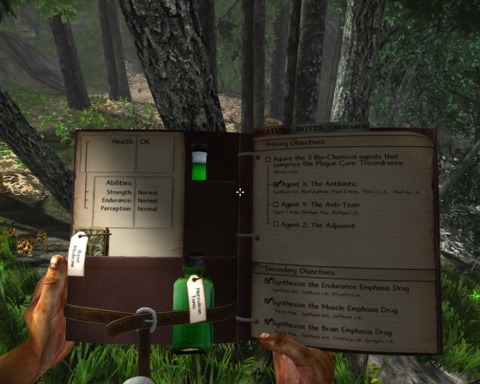
I’ll let you in on a little secret: Miasmata was the impetus behind this entire post. No game surprised me as much as Miasmata did last year, a unique experience that was shockingly enjoyable. I had been intrigued ever since seeing it on the Quick Look, but I wasn’t exactly excited to start playing it. In fact, I used a random number generator to pick this game by chance; what a lucky happenstance that was! Miasmata’s gameplay revolves around two major gameplay elements: exploration and cartography. You come to an island looking for a cure to the disease running inside your veins. Originally, a group of researchers established outposts on the island with the hopes of creating a cure to the same disease. You spend most of the game walking around the sizeable landmass, looking for the various outposts and the journals they contain, complete with clues on what is needed to synthesize a cure for your illness. That illness often leaves you weak and prone to injury.
To make matters worse, you have to be careful navigating the world due to Miasmata’s momentum-based movement: one step too many can give your character kinetic energy that easily carries him over an incline and sends him tumbling head-over-heels, nearly dead from the exertion. It’s a tricky system to manage, making even a simple walk down a steep slope a dangerous endeavor, but it also lends an enjoyable puzzle-like element to simple navigation of the environment. To keep track of your progress, you are expected to engage in some basic cartography. This system has you marking down big visual landmarks from two separate locations in order to cross-reference your position and expand your map. You need to do this constantly to keep from getting painfully lost, as the map does not update automatically. The cartography is a bit finicky, with certain landmarks refusing to trigger, but it adds the same level of responsibility to your exploration as the movement; without some leg-work, you will have a hard time finding out where to go or even keeping track of where you are. Together, these systems make for gameplay that is somehow rewarding and fun despite being little other than exploration. Miasmata is a singular vision from a team of just two brothers, content to be what it is and unashamed of its flaws borne from ambition.
Freedom Fighters (finished on June 18)
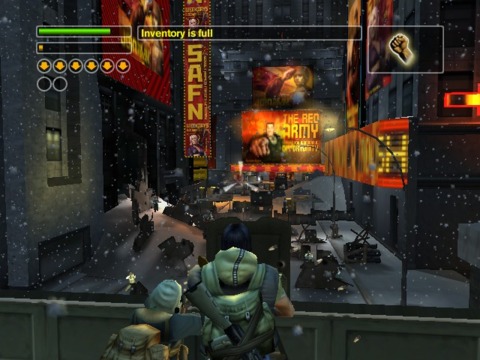
Freedom Fighters is another one of those games I really wish I had played sooner. Time and time again, I heard people mention it as one of the great PS2/Xbox/GC era games, melding shooting and squad mechanics skillfully together. Now that I’ve finally played it, I have to agree. The shooting mechanics haven’t held up well over the last decade, using an awkward scheme with a strange button configuration and loose aiming controls. If Freedom Fighters only had its shooting, it would be nearly unplayable today. Thankfully, it also has some of the slickest squad mechanics I’ve seen in a game outside of an RTS. You recruit several soldiers to your cause (with the number of maximum soldiers increasing as you progress) and command them to hold positions, attack targets, and essentially be bullet shields for your weak player character. By the time you reach the end of the game, nearly all of your fighting will be done through these proxy AI characters, leaving you to strategize each encounter instead of struggling to kill a handful of enemies yourself.
The mission structure is surprisingly open, giving you multiple levels with targets to attack and offering a choice in which order to take them out. Tired of that pesky air support hounding you? Go to the helipad and bomb the helicopters. Too many soldiers defending an important base? Take the barracks and limit the number of potential reinforcements. This level of freedom still isn’t commonly found in games today, making Freedom Fighters that much more impressive. I won’t say I wasn’t frustrated with the game on numerous occasions, as a mass of your own soldiers and some trial-and-error are almost required in order to claim victory in later levels, but the gameplay ideas here are a lot of fun. Now, I’m lending my voice to those who demand a sequel: just imagine what it could be on current-gen consoles!
Final Fantasy XII (finished on July 12)
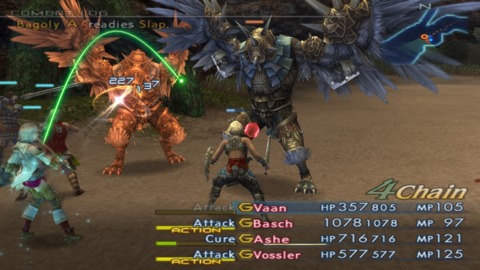
2014 was a sort of vision quest for me, in regards to Final Fantasy. Since I was already trying my hardest to knock out some backlog games, I figured I should also fill out some of the gaps in my knowledge and at least attempt to play each Final Fantasy game I had never tried. This led to me playing, and finishing, 5 (!) entire Final Fantasy games in 2014, ending with Final Fantasy XII in July. XII is an odd Final Fantasy game, coming out at a time when MMO games were newly popular (thanks to World of Warcraft). As such, the developers crafted a combat system that feels like a melding between a traditional FF system and MMO combat. The result is a largely automated game that revolves around Gambits, predetermined if-then statements that you setup on each of your characters. These allow you to tell the computer to do things like attack the nearest enemy, cast Cure when an ally is weak, and use specific types of magic on enemies that are weak to them. It’s like programming your party to fight for you, sitting back and watching the fights happen on their own.
While this combat system has been demonized by many fans of the series for its hands-off nature, I absolutely loved it. Similar to XIII’s Paradigm system, it shifts the focus of combat from rote menu navigation through pointless battle after pointless battle to active strategizing and adaptation to the creatures of an area. Once I set up my Gambits for a new zone, I could simply walk from group to group and let the AI handle the boring parts of random encounters. When I wanted to grind, a few adjustments to my Gambits made it fun, something I can’t say about grinding in many other games. I can certainly understand those who criticize the autonomous nature of XII’s combat, as it can feel as if the game is playing itself at times, but it’s such a clever system that I couldn’t help but be impressed. Furthermore, it keeps the combat from turning into endless chains of hammering on the confirm button, only relying on the player to move from encounter to encounter once the proper Gambits have been established. As someone who often finds combat to be the most tedious and annoying part of any JRPG, I found the ability to simplify the ordeal incredibly smart. There are certainly things to hate about Final Fantasy XII--namely the boring story filled with awful characters--but it has become one of my top 3 in the series. Now, if Square would only bring out the IZJS (International Zodiac Job System) in the US...
